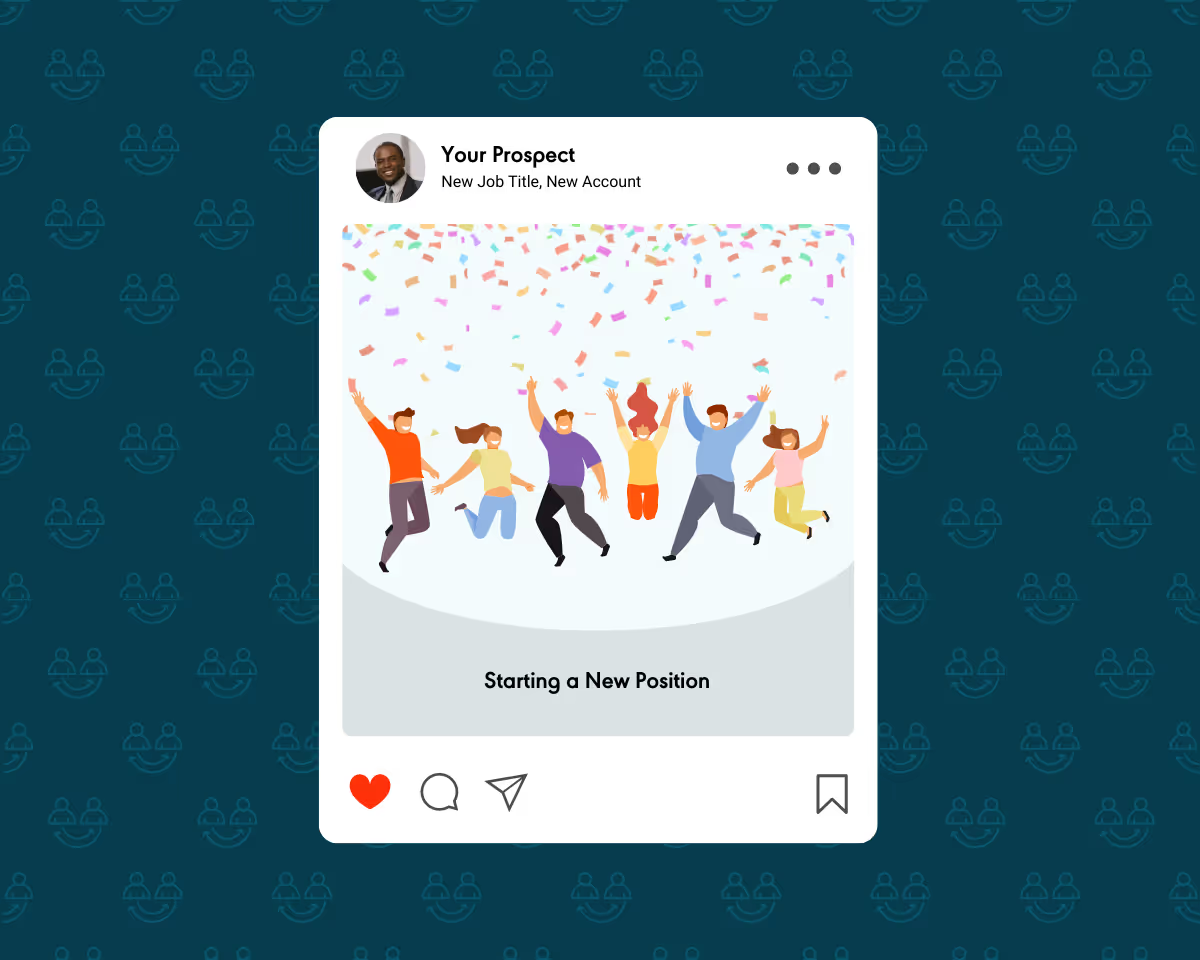Ready to create more pipeline?
Get a demo and discover why thousands of SDR and Sales teams trust LeadIQ to help them build pipeline confidently.



Leveraging job change notifications allows sales teams to tailor their outreach more effectively by identifying when potential or existing contacts move to new roles or companies.

By understanding the new challenges and priorities a contact may have in their new role, sales reps can personalize their messages to align with the contact's current needs, enhancing the relevance and impact of their outreach.

Early engagement with contacts who have recently changed jobs can help establish or re-establish relationships, providing a strategic advantage in addressing their new requirements and potentially converting them into customers.
Get a demo and discover why thousands of SDR and Sales teams trust LeadIQ to help them build pipeline confidently.
The best sellers aren't looking for excuses to reach out but for needs to be met.
When outreach and need overlap, your message comes across as helping. When they don’t, you might find yourself falling into the spam category.
How, then, can your sellers avoid being spammy and instead discover a company or prospect’s need? There’s a big tell that can often be overlooked – The company’s hiring strategy and job changes.
Looking into company job postings, monitoring promotions, and keeping track of individuals changing jobs can offer a big window into a company’s strategy, pain points, and needs. Do you sell marketing collaboration software? You can build a prospecting strategy by looking at companies hiring a new CMO or decision-maker.
When starting a new job, there’s often a hurry to impress, a lot of new needs to be met, and budgets to be spent to achieve goals and objectives. But you can also lose big if you ignore job change activity in strategic accounts or fail to respond fast.
So let’s take a look at how sellers can leverage job change notifications for cold outreach.
Ok, first up, the basics.
Job change notifications are alerts that notify you when someone in your target market changes their position. Typically this is either by joining a new company or being promoted from within.
Sales professionals can use various tools to track job changes, including CRM systems, sales prospecting platforms, and social media monitoring tools. LinkedIn Sales Navigator is a great source for tracking job changes, but more and more sales tools are building job change notifications into their offerings.
A change in an account’s personnel can significantly impact your sales cycle. Tracking job changes can help your reps stay ahead of the curve, stay informed about what’s going on with their accounts, and better prepare for any potential roadblocks or additional opportunities that could result from a change.
Job change notifications can help your sales team adjust their approach when:
Don’t get blindsided by a new decision maker entering the conversation as your deal is progressing. While this problem isn’t just tied to new people starting at the company your prospecting for, being aware of new hires can help you prepare for the possibility of someone entering the picture.
A new decision maker may have different priorities, goals, and preferences. Proactively reaching out and establishing a relationship early can get you in front of this potential roadblock, build a new sales pitch, and continue to build trust with the customer.
Nothing hurts more than when a key champion leaves your account. This can easily cause your sale to be delayed or halted altogether. Being alerted about this situation early can make it easier to get in front of this roadblock and focusing building relationships with other people involved with the sale.
A prospect leaving an account can also offer insights into the company overall. Did the prospect leave for a better opportunity, or have there been major organizational shifts that resulted in layoffs? If it’s the latter, sellers need to prepare for possible changes in budget, priorities, and business needs.
Of course, job changes offer plenty of opportunities for sellers too. In fact, it can really open up some great low-hanging fruit for a sales rep: Taking someone who was already a customer, and making them a customer again. With that said, lets talk about…
It’s amazing how often this goes overlooked, but keeping tabs on your current customers through job change notifications can be an easy (ok, easier, nothing is easy in sales) way into an account, especially if you have an established relationship with that individual and they had a positive experience with your product.
If they did have a great experience as a past customer, they’re going to remember the quality of the product and the level of service or attention they received.
Keep in touch with these opportunities to remind continue to build this relationship. When they person is in a position to start making purchasing decisions, you’re going to remain top of mind for them.
Everything we just talked about is easier said than done. We all know how hard prospecting and cold outreach can be, and all of these scenarios are no different.
Here's a simple framework you can use with your sales organization to leverage job change notifications, account tracking, and contact tracking to keep your pipeline and revenue growing.
There are typically two different ways you can receive job change notifications. That’s by tracking accounts or individual contacts. Let’s briefly talk about each one and how LeadIQ handles each method as part of a seller’s prospecting workflow.

Account tracking surfaces promotions, exits, and new hires across a company. It keeps tabs on companies or organizations you’re targeting as potential customers or ones who already are.
LeadIQ's Track function lets you keep abreast of job changes within an account so you can reach out when high-value personas are more receptive to help. This is great for net new accounts, but also current customers to help avoid churn (by getting notified if a key contact leaves) and expanding into new teams or regions within the account.
For example, "Buyers who have recently posted a job change on LinkedIn are 65% more likely to accept an InMail."
It might help to think of sellers like generals and accounts like territories. Sellers want to conquer new territories and still protect their own lands. Account tracking helps detect opportunities and threats, but knowing a territory's status is only half the battle.
The best generals keep tabs, not just on territories, but on who to mobilize. Monitoring key relationships is called contact tracking.
Sales is relational, and relationships need nourishment so they don't wither.
In the past, sellers stayed aware of their contacts with manual research. Today, sellers use tracking capabilities to detect when contacts change departments, get promoted, or move to a new company.
These insights give you the opportunity to sell to someone who knows your product or who can be an advocate instead of starting from scratch.
With a tool like LeadIQ, this process can be pretty simple:
While it's great to follow a contact at a new company, what about the place they left? Sometimes, when a champion leaves a job, they cram their advocacy in a suitcase and take it with them.
Alerts are a reminder to secure that account's stakeholders. You don't want to introduce yourself to a group of strangers when it's time for them to renew. "Almost nine in 10 sellers say they have seen a deal lost or delayed in the past year by a decision maker changing roles." Use contact tracking to nurture your relationships, and keep alert to those who can come to your aid.
Aside from allies, you may have detractors. If so, put them on your watchlist, and Track can alert you when the coast is clear. Then, crack your knuckles and unleash the power of your sales fingers!
Though it can be hard to know the most effective time to reach out, account tracking and contact tracking bring your attention to opportunities and threats. Additionally, they let you overlap outreach with need. Your prospects call it "help," and LeadIQ can help make it happen.
Using job change notifications for cold outreach can be a great way to connect with potential clients or customers who are likely to be receptive to your message. By taking the time to research the individual and craft a personalized message, you can increase your chances of success with your outreach efforts.
Of course you can learn more about how LeadIQ leverages job change notifications, account tracking, and contact tracking by exploring our website or contacting our sales team to schedule a demo.